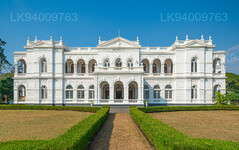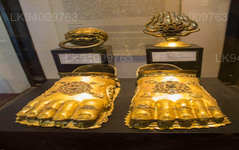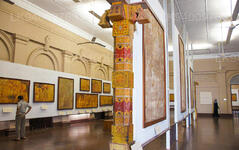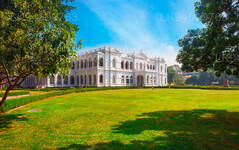
콜롬보 시
스리랑카의 수도 콜롬보는 전통과 현대가 조화를 이루는 역동적인 도시입니다. 식민지 시대 건축물, 활기 넘치는 시장, 그리고 고요한 불교 사원을 만나볼 수 있습니다. 다채로운 요리, 성장하는 스카이라인, 그리고 아름다운 해변을 자랑하는 콜롬보는 비즈니스, 문화, 관광의 중심지로서 스리랑카의 경이로움을 탐험할 수 있는 관문 역할을 합니다.
National Museum
National Museum of Sri Lanka: The House of History
The National Museum of Sri Lanka, also most commonly known as the Sri Lanka National Museum is cosidered to be the largest Museum in Sri Lanka. It is maintained by its own dedicated Department of National Museum in Sri Lanka. It is home to many valuable and historically important objects such as the throne and the crown of the Kandyan Monarchs.
National Museum of Sri Lanka: The Story behind the History
The Colombo Museum was established in 1st January 1877. It was founded by the British Governor of Ceylon at the time; Sir William Gregory.
The architect of the Public Works department, J.G. Smither was able to prepare plans for the new structure based on Italian architecture style.
The construction of the Museum was carried out by Arasi Marikar Wapchie Marikar (born 1829, died 1925, aka Wapchi Marikar Bass. Wapchi Marikar Bass has an extensive resume that made him the perfect man for this immense project. He was the builder of the General Post Office in Colombo, Colombo Customs, Old Town Hall in Pettah, Galle Face Hotel, Victoria Arcade, Finlay Moir building, the Clock Tower, Batternburg Battery and many other buildings some of which are still standing today. The construction was completed in 1876 and commissioned to be opened the following year. The completed building of the Colombo Museum was declared open by Governor Gregory, in the presence of a large crowd.
Several other wings were added from time to time under the direction of Dr. Arthur Willey and Dr. Joseph Pearson new structures were built during the period of Dr. P. E. P. Deraniyagala, Dr. P. H. D. H. de Silva and Sirinimal Lakdusinghe. One of the natural history museum, and yet another consists of the auditorium.
National Museum of Sri Lanka: Recent developments
The museum was given the status of a national museum during the period of P. E. P. Deraniyagala. Under his supervision branch museums were opened in Jaffna, Kandy, and Ratnapura and a fully-fledged department of national museum was established in 1942 under the act No. 31. Nine branch museums were ultimately opened, and a school science program and a mobile museum law essay writing uk service are also in operation.
National Museum of Sri Lanka: The Library
Along with the Colombo National Museum the Library was also established in the 1st of January in 1877. The Government Oriental library (1870) was incorporated in to Colombo National Museum Library, and served as the nucleus of the library collection by collecting the local publications during the past 129 years.This huge collection of the library could be separated in to various groups according to the document type.
1. Palm leaf collection which are written in Sinhala, Pali, Sanskrit, Burmese, Telegu and Tamil characters among the subjects covered are Buddhism, Sinhala literature, History, Indigenous Medicine, Astrology, Demonology, Veterinary Science, Art, Architecture and Folklore.
2. Printed books and Pamphlets, This collection comprises the entire range of documents from the first work printed in 1737 to the latest book.
3. Periodical collections such as Journal of the Royal Asiatic Society (CB), Ceylon Antiquary and Literary Register, Young Ceylon etc. The collection was built up to a great extent by exchanges received from the institutions in all parts of the globe. Foreign periodical collection contains important titles such as discovery reports, Ray Society publications among many others.
4. Government Publications such as Blue books from 1864-1938, Administration Reports from 1867 to date, Sessional papers from 1860 up to date, Hansards
from 1863-1962 etc.
5. Directories, Statistical year books, Trade catalogues etc.
6. Law Reports
7. Maps and Drawings
National Museum of Sri Lanka: Photography Division
The Photography Division of the Department of National Museums was established in 1950. Photographs related to the museum objects supply to other divisions of the department and external parties is the main task of this division.
Services of this division are:
Photograph museum objects, faunal and floral specimen, geological items and supply photographs to the relevant divisions where necessary. Sale of photographs of museum objects to external parties with the orderly approval from the Director. Negatives, photographs taken by the digital camera store on CD’s, registration and conservation.
National Museum of Sri Lanka: Information Technology division
The Information Technology division of National Museum of Sri Lanka is used to archive the all the data in the Museum and save it in a safe form. It also takes care of online queries and maintaining the museum web page.
콜롬보 지구 소개
콜롬보는 스리랑카에서 가장 큰 도시이자 상업 중심지입니다. 섬의 서쪽 해안에 위치하며 수도인 스리자야와르데네푸라코테와 인접해 있습니다. 콜롬보는 현대적인 삶과 식민지 시대 건물 및 유적이 조화를 이루는 활기 넘치는 도시로, 인구는 647,100명입니다. 콜롬보, 감파하, 칼루타라 지구로 구분되는 콜롬보 수도권은 약 5,648,000명의 인구를 보유하고 있으며, 면적은 3,694.20km²입니다. 콜롬보는 다민족, 다문화 도시입니다. 스리랑카에서 인구가 가장 많은 도시로, 시 경계 내에 642,163명이 거주합니다. 콜롬보의 인구는 주로 싱할라족, 무어족, 타밀족 등 다양한 민족이 혼합되어 있습니다. 이 도시에는 중국, 포르투갈, 네덜란드, 말레이, 인도계 주민들로 구성된 소규모 공동체와 수많은 유럽계 외국인들이 거주하고 있습니다. 스리랑카 기업의 대다수는 콜롬보에 본사를 두고 있습니다. 화학, 섬유, 유리, 시멘트, 가죽 제품, 가구, 보석류 등의 산업이 이곳에 있습니다. 시내 중심부에는 남아시아에서 두 번째로 높은 건물인 세계 무역 센터가 있습니다.
서부 지방에 대하여
서부 주는 스리랑카에서 인구 밀도가 가장 높은 주입니다. 입법 수도인 스리자야와르데네푸라코테와 국가의 행정 및 비즈니스 중심지인 콜롬보가 있습니다. 서부 주는 콜롬보(642km²), 감파하(1,386.6km²), 칼루타라(1,606km²)의 세 개의 주요 지구로 나뉩니다. 스리랑카의 경제 중심지인 서부 주에는 모든 주요 국내 및 국제 기업과 유명 디자이너 및 대형 유통업체가 자리 잡고 있습니다. 따라서 서부 주에서 쇼핑을 즐길 준비를 하세요. 모든 주에서 인구가 가장 많은 서부 주에는 섬의 거의 모든 주요 교육 기관이 위치해 있습니다. 이 지방의 대학으로는 콜롬보 대학, 스리자야와르데네푸라 대학, 켈라니야 대학, 스리랑카 오픈 대학, 스리랑카 불교 및 팔리어 대학, 존 코텔라왈라 국방 대학, 모라투와 대학이 있습니다. 서부 지방에는 국립, 지방, 사립 및 국제 학교를 포함하여 전국에서 가장 많은 학교가 있습니다.










































